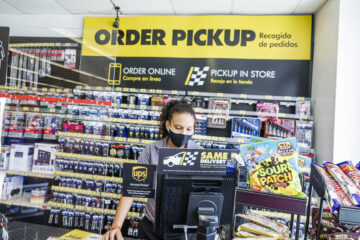Organized retail crime has become one of those vague things that the entire retail industry (save Costco) seems to have pointed to as the villain in their story.
This isn’t just a kid stealing a candy bar or someone not scanning their most expensive items in self-checkout. It’s an organized effort to steal from retailers.
The term evokes the mob, or major crime syndicates, and you can sort of picture Elliot Stabler spending a “Law & Order: Organized Crime” season working to take down a big boss who has used minions to defraud department stores out of millions.
Related: Target CEO defends unpopular theft prevention policy
On the surface, organized retail crime seems really scary. It’s sophisticated criminals taking on retailers who aren’t exactly using Las Vegas Strip casino-level security systems.
Organized retail crime “typically involves a criminal enterprise employing a group of individuals who steal large quantities of merchandise from a number of stores and a fencing operation that converts the stolen goods into cash,” the National Retail Federation explains on its website.
“Stolen items can be sold through online auction sites, at flea markets and even to other retailers.”
The problem also makes for dramatic video on social media, where organized smash-and-grabs look terrifying.
The depth of the problem, however, may not be worth the alarms companies like Walmart. Target and Walgreens have sounded.
Walgreens was one of the companies that sounded alarms on retail theft.
Image source: Shutterstock
Retail group made a huge reporting mistake
Theft numbers are part of what the industry calls shrink. Some shrink is shoplifting, some is organized retail crime, some comes from employee theft, and items also can be lost in less nefarious ways. An April report from NRF, showed that organized retail crime was a massive part of overall shrink for retailers.
“In the original report, dedicated to organized retail crime and conducted with risk, compliance, investigations and monitoring firm K2 Integrity, the group had said that shrink was $94.5 billion in 2021, ‘nearly half of which was attributable to” organized retail crime, Retail Dive reported.
The problem is that the data used also included shrink from process errors and inventory loss that had nothing to do with crime as well as theft. So, after Retail Dive questioned the data, the NRF updated the report.
Basically, while no actual new numbers have been provided, the data show that organized retail crime does not account for anywhere near half of all shrink.
“According to its most recent report on shrink, about 29% is lost because employees steal merchandise or money and another 34% is lost to process errors or for unknown or other reasons. The remaining 36% is from external theft, of which organized retail crime is a subset,” the website reported.
Retailers see theft as a huge problem
In various quarterly earnings calls, leaders from Target (TGT) – Get Free Report, Walmart and Walgreens have blamed theft and organized retail crime for thinner profit margins.
Shrink has increased but it has not exploded, according to NRF data.
“The average shrink rate in FY 2022 increased to 1.6%, up from 1.4% the previous year,” the trade association shared.
Even Walgreens CEO James Kehoe earlier this year said he may have overstated the problem.
“Maybe we cried too much last year when we were hitting numbers that were 3.5% of sales,” Kehoe said, according to an earnings call transcript. “We’re down in the lower twos, call it, the mid-2.5, 2.6 kind of range now.”
That’s still above the NRF industry average, but the grab and go nature of pharmacies, along with the merchandise they sell, likely explains that.
The Target and Walmart CEOs have also both addressed increased theft during earnings calls and have taken steps to stop it. Walmart has gone so far as adding a police station to one Atlanta-area store and increasing its policing of self-checkout lanes.
In Target’s case, the retailer has closed stores in some cities and has tested limiting the amount of items that can be checked out at self-checkout lanes.
Both companies have also tested higher-tech solutions that use artificial intelligence to cut down on theft, but for obvious reasons neither company comments much on their specific tactics.
Unlock the secrets of the stock market with Real Money Pro. Gain direct access to elite portfolio managers’ top stock picks and time-tested investment strategies. Embark on your journey to financial success — start now.


